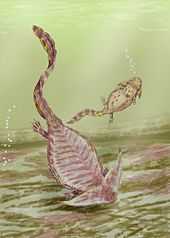Diplocaulus
| Diplocaulus Temporal range: 299–251Ma Early to Late Permian | |
|---|---|
| | |
| Diplocaulus magnicornus | |
| Scientific classification | |
| Kingdom: | Animalia |
| Phylum: | Chordata |
| Class: | "Amphibia" (wide sense) |
| Subclass: | †Lepospondyli |
| Order: | †Nectridea |
| Family: | †Diplocaulidae |
| Genus: | †Diplocaulus Cope, 1877 |
| Species | |
| |
| Synonyms | |
|
Genus-level:
Species-level:
| |
Diplocaulus (meaning "double caul") is an extinct genus of lepospondyl amphibian from the Permian period of North America. It is one of the largest lepospondyls, with a distinctive boomerang-shaped skull. Remains attributed to Diplocaulus have been found from the Late Permian of Morocco and represent the youngest known occurrence of a lepospondyl.
Description
Diplocaulus had a stocky, salamander-like body, but was relatively large, reaching up to 1 metre (3.3 ft) in length. Its most distinctive features were the long protrusions on the sides of its skull, giving the head a boomerang shape.[1] Judging from its weak limbs and relatively short tail, it is presumed to have swum with an up-and-down movement of its body, not unlike cetaceans today. The wide head could have acted like a hydrofoil, helping the creature glide through the water. The University of Michigan's exhibit takes this concept on step further, adding a sheet of loose skin from the tips of the skull to the base of the tail which would have moved in an undulating wave for forward motion. Another possibility is that the shape was defensive, since even a large predator would have a hard time trying to swallow a creature with such a wide head.[2]
A close relative of Diplocaulus is Diploceraspis.
Diplocaulus on display
- The fossilized skeleton of a Diplocaulus is on display at the University of Michigan Museum of Natural History in Ann Arbor, Michigan. The display presents art of the Diplocaulus with the controversial skin extending from the tips of the head to the tail.
- The fossilized skeleton of a Diplocaulus is on display at the Houston Museum of Natural Science in Houston, Texas.
Gallery
-
Skull of Diplocaulus magnicornis at the Museum für Naturkunde Berlin
-

-

-

References
| Wikimedia Commons has media related to Diplocaulus. |
- ↑ Cruickshank, A. R. I.; Skews, B. W. (1980). "The Functional Significance of Nectridean Tabular Horns (Amphibia: Lepospondyli)". Proceedings of the Royal Society B: Biological Sciences 209 (1177): 513. doi:10.1098/rspb.1980.0110.
- ↑ Palmer, D., ed. (1999). The Marshall Illustrated Encyclopedia of Dinosaurs and Prehistoric Animals. London: Marshall Editions. p. 55. ISBN 1-84028-152-9.
| ||||||||||||||||||||||||||||||||
